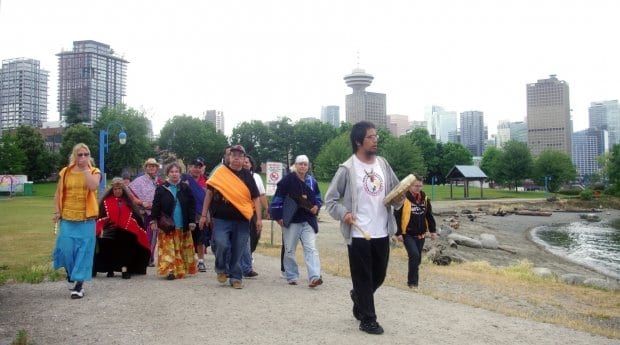Residents of Vancouver’s Downtown Eastside held their first Pride parade July 19 and plan to make it an annual celebration.
“We’re bringing Pride to the people who really, really need it the most,” organizer Roseanne Gervais says.
Approximately 25 people participated in the parade, which began at Crab Park and continued south along the sidewalk of Main Street, east on Hastings Street and north on Jackson to Oppenheimer Park. The day’s events also included workshops and a film screening at the Carnegie Community Centre.
“Pre-colonization there was no need for Pride parades of any kind,” Gervais says. “There was no need because everyone was honoured as sacred, and we’re learning the language that we unlearned in the past 500 years.”
She says existing Pride events are too far or too expensive for many neighbourhood residents to attend.
“We don’t really have true solidarity until we address the issue that there are two-spirit, queer, lesbian, bisexual and trans people in the Downtown Eastside who are not being served,” she says. “There’s a huge gap in service in Vancouver Coastal Health and all the Metro Vancouver health authorities for two-spirit, trans and queer people but in particular in the Downtown Eastside, which seems to have become a bit of a dumping ground for all the people who need housing.”
Star Joinson says the celebration brought some much-needed colour to the area. “I’ve been living down in this neighbourhood for the past three months in a shelter, waiting to get housing,” she says. “I’m familiar with the hardship that people in the Downtown Eastside go through; as well, there seems to be lacking a lot of colour and joy in the Downtown Eastside. It’s a hard time, and it’s nice to see joy down here.”
Synder Starr, Princess XXXVII of the Greater Vancouver Native Cultural Society, says the celebration is a significant acknowledgment of two-spirit people and their traditions.
“There’s never been anything like this that is significant to them or would acknowledge them because we, as white people, always kind of kept them down, taken things from them,” she says. “So I guess for me, this is about celebrating and embracing the brotherhood and sisterhood of indigenous people.”
The event was rooted in indigenous culture, history and traditions, beginning with an acknowledgment of area First Nations, as well as a blanket wrapping of two-spirit elders, which signified that they are witnesses to the day’s events. Participants also honoured the dead and missing by laying cedar sprigs and potted sunflowers at the Crab Park memorial for missing women.
“That’s one thing I like about the First Nations or aboriginal community is they do everything traditionally,” Starr says. “They welcome and bless everything, and I find that’s really important to me. If you don’t give thanks to the land and everything we’re on, then you can’t really have a positive celebration, you know. You have to give thanks to our creator and everything else.”
Imtiaz Popat, who is seeking nomination as a COPE candidate for the Vancouver Board of Parks and Recreation, described the Pride event as a “very earthy” celebration and a welcome addition to Pride season.
“I think this is where it’s at,” he says. “This is where the activists are and there are no floats or fanfare, but there’s a bunch of people marching just like the very first Pride parade in Vancouver.”
He believes the event is needed because people in the Downtown Eastside are frequently forgotten.
“They don’t get included in the celebrations, and they don’t get elected representation,” he says. “So when we’re sitting there on park board or council or whatever, we forget the people downtown there who are in tents in this park right now,” he says, pointing toward the tent city at Oppenheimer Park.

 Why you can trust Xtra
Why you can trust Xtra


